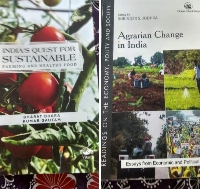Since inception, we all in Agragamee working in the tribal hinterland are researching, debating and discussing the scope and content of TRIBAL AGRICULTURE as part of tribal ecosystem. We can write a historical note how it has gone through many phases of transformation. This debate has included many issues related to a) Shifting Cultivation, b) Agroforestry and SALT (Sloping Agricultural Land Technology), c) Watershed Development, d) Plantations, e) Subsistence Agriculture vis-a- vis Market driven Agriculture, f) Agriculture for Food, Nutrition and Livelihood Securities, g) Agroecology and Sustainable Agriculture. In 1980, when we had come to Kashipur, we had observed there was hardly any use of Chemical Fertilisers and Pesticides or HYVs. Any commercial plantations like Eucalyptus, Jatropha, Cotton were hardly encouraged. Most of the tribals were happy with their traditional systems of Agriculture and Agroecology. There was no impact of so-called Green Revolution as it was almost a Total Rainfed Agriculture. If some tribal villages have access to Irrigation, the crops taken were indigenous maize and some summer vegetables. Kashipur had no access to Market due to inaccessibility and limited knowledge on so called modern Agriculture. I was trying to collect the history of various Agriculture practices. It seems there was an introduction of Monsoon Potatoes as climate and land were most suitable. There was bumper production as narrated by the tribals. But there was no market and no cold storage facilities. The farmers could not sell. The potatoes were rotting everywhere. Kashipur was also known for rich Kandul/Indigenous varieties of Pigeon Pea. The production of Dangar rani( Rice beans) was widespread but the entire harvest was sold to the traders and moneylenders. The cash crop of Niger/Alsi (Oilseeds ) was taken almost in every hill-slopes bringing a riot of yellow in the entire landscape. The huge production of Niger was also facing distress sale due to the market controlled by the traders and moneylenders. In some of the villages, the farmers were producing aromatic rice like Tulsibasa, Samudrabali, Kalajeera ( local names), etc though in a limited way. Many tribals were producing a range of millets like Finger Millets, Foxtail Millets, etc. as these were the staples. Kashipur was also known for local varieties of Mangoes and Jackfruits. Despite all this agricultural produce, there was a shortage of food and widespread starvation. Kashipur had a history of tribals eating Mango Kernels and Tamarind seeds! The root cause of this starvation was the moneylending and market-driven economy!

In last 40 years, there have been some dramatic changes in Tribal Agriculture. There is a drastic fall in the production of Pulses like Kandul and Rice Beans, Oilseeds like Niger, Aromatic rice/ Upland paddy. The practice of Shifting Cultivation has diminished as the hills have become barren and the soil has become degraded. More and more Farmers are losing their interest in Agriculture. The youths have given up farming practices but prefer to migrate. Quite a bit of land has been converted into Eucalyptus Plantation. Extensive Mango and Cashew Plantations have also been taken up in Kashipur. Sometime back, most of the tribal farmers were pushed to use Chemical Fertilisers and Pesticides widely, in almost every crop they were taking. The Agriculture Departments have also encouraged chemical agriculture and HYV Seeds under different programmes to boost production as a special drive to bring in the components of Green Revolution. Knowingly and unknowingly, whether the tribal farmers have been the victims or not can be an interesting socio-economic and ecological study . With the changing of tribal eco-systems, the issues related to the securities of Food, Nutrition and Livelihood organically related to Tribal Agriculture have become a matter of grave concern.
However, there has to be a systematic efforts to make the tribal farmers understand a few burning issues related to the current practice of Agriculture such as 1) Food and Farming Policies, 2) Safe and Nutritious Food, 3) Sustainable Livelihood of Small Land holders 4) Land Fertility Status, 5) Traditional Seeds and Bio-diversity Conservation, 6) Agro-ecological Practices, 7) Natural Farming and, above all, 8) Impact of Climate Change.
I see a ray of hope that now in Kashipur and other tribal areas in South Odisha, there are special efforts to revive traditional Millets through Odisha Millet Mission and traditional Farming Practices by programmes like Paramparagat Krishi Vikash Yojana (PKVY) and Bharatiya Prakrutika Krishi Paddhati (BPKP). A process of discussion and dialogue has been initiated to bring back the tribals to their traditional farming system and Agro-ecological practices. It is very challenging at the present juncture to stop the chemical agriculture completely and start the process of Natural Farming unless there is full understanding internalization on of Natural/Ecological Farming Principles at l levels. But there a hope. Unless there is a concerted effort by all the stakeholders including the Agriculture Department, aided the by right kind of policies and programs, nothing substantial will be achieved the in next few years! Agragamee is also promoting Eco-village Development in our tribal villages with some degree of success. We have miles to go.
By- Achyut Das (Director- Agragamee)

